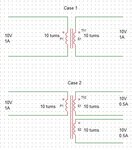pawan kumar
Member level 4

Hi Friends,
I accept that the law of conservation of energy can never go false. I got this doubt, if answered, many like me may get benefited.
Consider the image below, Case 1: 10W is transferred ideally agreed.

In case 2, is there any way magnetically to prove that since the power input = power o/p, the current gets halved?
What if there is another secondary winding close by... How can the coils understand that and divide current accordingly?
Has this something to do with Mutual inductance? if yes, please guide me on where to read further..
Pawan
I accept that the law of conservation of energy can never go false. I got this doubt, if answered, many like me may get benefited.
Consider the image below, Case 1: 10W is transferred ideally agreed.

In case 2, is there any way magnetically to prove that since the power input = power o/p, the current gets halved?
What if there is another secondary winding close by... How can the coils understand that and divide current accordingly?
Has this something to do with Mutual inductance? if yes, please guide me on where to read further..
Pawan
